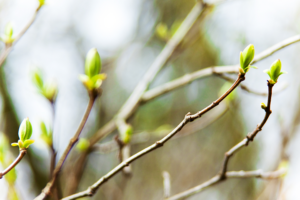
As the chill of winter gives way to the gentle warmth of spring, our outdoor spaces come alive with the promise of blooming flowers and vibrant greenery. Amidst this natural spectacle, our trees stand as silent guardians, ready to burst forth with new life. To ensure your trees thrive in the upcoming season, we present a comprehensive guide on preparing for spring in Eastern Massachusetts, covering essential aspects like pruning for new growth, disease prevention, and maintaining overall tree health.
Pruning for New Growth: Sculpting Nature’s Canvas
Spring pruning is an art that goes beyond aesthetics—it’s a vital practice to stimulate new growth and enhance the overall well-being of your trees. As we bid farewell to winter, it’s the perfect time to carefully shape and trim your trees.
Why Prune in Spring?
During winter, trees undergo a period of dormancy, and pruning during this time minimizes stress on the tree. As spring approaches, the tree’s energy shifts towards growth, making it an opportune moment to guide its development.
Tips for Effective Late Winter and Early Spring Pruning:
- Identify Dead or Damaged Branches: Remove any limbs that didn’t survive the winter or show signs of disease. This not only improves the tree’s appearance but also prevents the spread of potential issues.
- Encourage Airflow: Thin out dense areas to allow sunlight and air to reach all parts of the tree. Improved airflow reduces the risk of fungal infections and promotes overall tree health.
- Shape for Aesthetics and Function: Prune with a purpose. Consider the tree’s natural shape and structure, removing any branches that hinder its growth or compromise its integrity.
Remember, each tree species may have specific pruning needs, so it’s advisable to tailor your approach accordingly and consult your local arborists.
Disease Prevention: Safeguarding Your Arboreal Assets
A healthy tree is better equipped to withstand environmental challenges, and disease prevention plays a crucial role in maintaining its vitality. Here are proactive measures to keep your trees resilient against common ailments.
- Regular Inspection: Frequent visual inspections of your trees can help catch early signs of disease. Look for unusual spots on leaves, discoloration, or abnormal growth patterns. Prompt identification allows for swift intervention.
- Proper Watering and Nutrition: Ensuring your trees receive adequate water and nutrients is fundamental to disease prevention. A well-hydrated tree is less susceptible to stress-related illnesses, and a balanced diet supports robust growth.
- Pruning Practices for Disease Prevention: Beyond shaping for aesthetics, pruning can also contribute to disease prevention. Removing dead or diseased branches eliminates potential breeding grounds for pests and fungi, promoting a healthier tree environment.
Ensuring Healthy Trees for Warmer Months: A Holistic Approach
As the temperature rises, it’s time to adopt a holistic approach to tree care. Beyond pruning and disease prevention, consider the following aspects to ensure your trees thrive during the warmer months.
- Soil Health: Healthy soil is the foundation of a flourishing landscape. Conduct soil tests to assess its composition and nutrient levels. Based on the results, amend the soil with organic matter to provide an optimal environment for root development.
- Mulching Matters: Mulching around your trees is a valuable practice, offering benefits like moisture regulation and weed suppression. However, finding the right balance is essential. Applying an appropriate layer of mulch—typically 2 to 4 inches—ensures soil moisture retention without overdoing it. Note: Beware of the “volcano mounding”, where excess mulch is piled against the tree trunk. This can lead to moisture retention, providing a breeding ground for pests and fungi, and may compromise the tree’s structural integrity. Follow best practices by spreading mulch evenly, leaving space around the trunk, and monitoring and adjusting regularly. Moderation is key to reaping the rewards of mulching while avoiding potential harm to your trees.
- Watering Wisely: Establish a consistent watering routine, especially during dry spells. Deep, infrequent watering encourages deep root growth and enhances the tree’s ability to withstand drought conditions.
Book a Spring Tree Care Assessment: Your Trees Deserve the Best
If you have any questions about the health of your trees or would like personalized advice tailored to your landscape, call Tree Tech, Inc. today. Our experts are here to help. Book a Spring Tree Care Assessment today and embark on a journey to a healthier, more vibrant outdoor space in Eastern Massachusetts.
As we welcome the arrival of spring, let’s join hands in nurturing nature and ensuring our trees stand tall, vibrant, and resilient in the face of the changing seasons.
A Guide to Preparing Your Trees for Spring Splendor in Eastern Massachusetts
Also Serving Rhode Island
Boston | Worcester | Cambridge | Brockton | Quincy | New Bedford | Fall River | Newton | Foxboro | Framingham | Plymouth | Attleboro | Taunton | Hingham | Needham | North Attleboro | Norton | Easton | Franklin | Walpole | Dover | Westwood
Providence | Warwick | Cranston | Pawtucket | Newport | Woonsocket | Cumberland | Coventry | Newport | Johnston | North Kingstown | Bristol | Portsmouth
Home » A Guide to Preparing Your Trees for Spring Splendor



